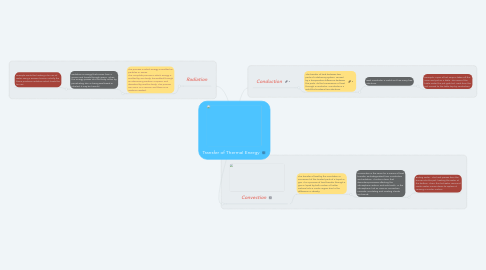
1. Convection
1.1. The transfer of heat by the circulation or movement of the heated parts of a liquid or gas. It is a process of heat transfer through a gas or liquid by bulk motion of hotter material into a cooler region due to the difference in density.
1.1.1. Convection is the name for a means of heat transfer, as distinguished from conduction and radiation. It is also a term that describes processes affecting the atmosphere, waters, and solid earth. In the atmosphere, hot air rises on convection currents, circulating and creating clouds and winds.
1.1.1.1. Boiling water - The heat passes from the burner into the pot, heating the water at the bottom. Then, this hot water rises and cooler water moves down to replace it, causing a circular motion.
2. Conduction
2.1. The transfer of heat between two parts of a stationary system, caused by a temperature difference between the parts. Its the transmission of heat through a conductor. Conductor is a solid that contains free electrons.
2.1.1. Best Conductor is metal as it has many free electrons.
2.1.1.1. Example, a pan of hot soup is taken off the oven and put on a table. The area of the table under the pot gets hot. Heat from the pot moved to the table top by conduction.
3. Radiation
3.1. The process in which energy is emitted as particles or waves. The complete process in which energy is emitted by one body, transmitted through an intervening medium or space, and absorbed by another body. This process can occur in a vacuum and there is no medium needed.
3.1.1. Radiation is energy that comes from a source and travels through space. When this energy passes into the body, either by penetrating skin or being swallowed or inhaled, it may be harmful.
3.1.1.1. Example would be heating a tin can of water using a Bunsen burner. Initially the flame produces radiation which heats the tin can.

